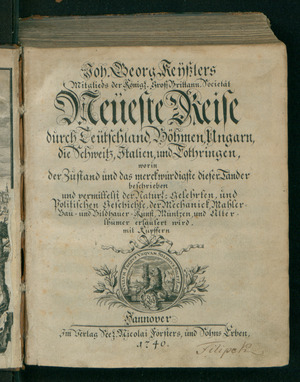Johann Georg Keyßler facts for kids
Johann Georg Keyßler (born 1693, died 1743) was a very smart German man who knew a lot about many different subjects. He was famous for his travel books and for studying old things (archaeology). People even call him the "father of German protohistory," which means he was very important in studying ancient times in Germany before written records.
Early Life and Learning
Johann Georg Keyßler was born in a place called Thurnau. He first went to study at a university in Halle. After finishing his studies, he went back to Thurnau. There, he started working for the Giech counts as a steward. A steward helps manage a large household or estate.
Later, he moved to Lauenburg to work for the Bernstorff counts. He became a tutor for their sons and grandsons. A tutor is like a private teacher.
Travels and Discoveries
As a tutor, Keyßler traveled a lot with his students. They went on many trips to different parts of Germany and even to other countries. In 1718, he visited England. While he was there, he was chosen to be a Fellow of the Royal Society. This is a big honor, as the Royal Society is a very old and famous group of scientists.
His Famous Travel Books
Keyßler wrote down all about his travels in books. These books were like a series of letters he had written. They are very important because they tell us a lot about the geography and cultural places of his time. They describe what different areas looked like and the interesting things he saw.
His books also talked about the political and economic situations in the German states. Because of this, some parts of his writings were removed or changed. This is called censorship.
His main book was called Neueste Reisen durch Deutschland, Böhmen, Ungarn, die Schweiz, Italien und Lothringen. It was first published in German in 1740 and 1741. An English version, called Travels through Germany, Bohemia, Hungary, Switzerland, Italy and Lorraine, came out later in 1756.
Later Life
Johann Georg Keyßler passed away at a place called Gut Stintenburg. Today, this area is known as Zarrentin am Schaalsee.
Sources


